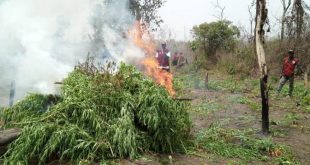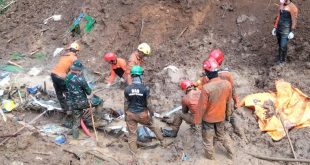BUENOS AIRES, Dec 10 (IPS) – The unprecedented development of renewable energies in Argentina during the last three years has borne its biggest fruit: the Cauchari photo voltaic park, with practically a million photovoltaic panels and 300 MW of put in energy, which was related to the nationwide energy grid on Sept. 26.
The photo voltaic park is positioned within the excessive northwest province of Jujuy some 1,700 km from Buenos Aires, close to the borders with Chile and Bolivia, with whom it shares the Puna ecoregion of excessive Andean plains lined by grasses and shrubs.
The initiative value 390 million dollars and is the newest reflection of China’s involvement within the Latin American financial system: not solely the 2 building corporations but additionally many of the financing got here from the Asian large.
An indigenous shepherd tending his llamas or a herd of untamed vicuñas that flee as quickly as they see a automobile approaching are the one sights that appeal to the customer’s consideration – as IPS discovered on a current go to to the realm – within the solitude of the arid Cauchari setting, which covers some 800 hectares within the Argentine Puna, at an altitude of greater than four,000 metres.
Between September 2018 and October 2019, 2,664 vehicles with containers loaded with Chinese language parts and expertise arrived at this distant spot so removed from the big centres of electrical energy consumption, the place water is scarce and it’s exhausting to breathe due to the altitude.
Beforehand that they had disembarked within the Chilean port of Antofagasta, on the Pacific Ocean, or within the Argentinean port of Zarate, on the Atlantic.
“It’s the largest working photo voltaic park in South America and we take into account it an excellent increase for altering the power combine in your entire area,” Guillermo Hoerth, president of Cauchari Photo voltaic, an organization owned by Jujuy province, advised IPS by cellphone.
“It’s nonetheless too early to say, as a result of we’re in a stage of adjustment and depend upon pure phenomena, however it’s more likely to be one of the environment friendly photo voltaic parks on this planet,” Hoerth added.
The president of the plant defined that the extreme photo voltaic radiation all year long is mixed with low temperatures, which assist the panels retain warmth and make the Puna a unprecedented place for one of these renewable power.
Cauchari is the best success story of the Law of National Promotion of the use of Renewable Energies for the Production of Electric Power, handed by Congress in September 2015.
The brand new legislation modified the electrical mixture of this Southern Cone nation, which is the third-largest financial system in Latin America, constructed till then nearly solely by oil, pure gasoline, massive hydroelectric dams and, to a a lot lesser extent, nuclear power.
In line with official information, 135 new renewable power tasks, principally photo voltaic and wind, have been launched in Argentina since 2016. Those already in operation and people which are nonetheless below building signify a mixed whole of four,776 MW of put in energy, with an estimated funding of near 7.2 billion dollars.
Essentially the most graphic reflection of the rise in renewable sources, which below the legislation have precedence over standard sources, is that they accounted for 9.1 % of the electrical energy consumed in Argentina within the first 10 months of 2020 and climbed to a report 11.9 % in October. Though it should be stored in thoughts that this occurred in a context of falling electrical energy consumption because of the drop in financial exercise on account of the COVID-19 pandemic.
Thus, renewable sources, which till three years in the past represented lower than two % of electrical energy technology in Argentina, reached – with a slight delay – the aim of contributing eight % of electrical energy, which Legislation 27191 of 2015 had set for Dec. 31, 2017.
The legislation outlines a second stage of the plan, with a aim of reaching 20 % by 2025. However consultants consider this shall be nearly unattainable to realize.
The worldwide financial disaster and Argentina’s financing issues – this 12 months the nation restructured nearly 66 billion dollars of debt with non-public collectors and nonetheless owes some 52 billion dollars to the IMF – are main obstacles.
However they aren’t the one ones.
“Argentina is a big nation, with nice potential for photo voltaic power within the north and wind power within the south,” economist Julián Rojo of the General Mosconi Argentine Institute of Energy, a non-governmental analysis organisation, advised IPS.
However “the issue is that for transporting electrical energy to the centres of consumption there’s a lack of excessive voltage traces, which at this time are near saturation. And there’s no intention of investing in new ones,” he mentioned in a phone dialog.
In Rojo’s view, Argentina doesn’t at present want further electrical energy technology, as a result of peak demand was reached in 2017 and, if vital, the nation has an vital gasoline pipeline community that makes it extra handy to construct thermal energy vegetation close to the centres of consumption.
Making an providing to Pacha Mama for the growth of the photo voltaic park
Marcelo Nieder, director of renewable power in Jujuy province, advised IPS that such a distant location was chosen to construct the Cauchari photo voltaic park not solely due to the wonderful photo voltaic radiation within the Puna ecoregion, but additionally as a result of a high-voltage line in-built 1999 to export electrical energy to Chile passes by the realm.
“Chile used it to provide its mining business, however since 2006 Argentina stopped promoting to Chile, so there was a risk to reap the benefits of the facility line,” he defined by cellphone from Jujuy, additionally the title of the provincial capital.
As a result of this excessive voltage line nonetheless has transport capability the governor of Jujuy, Gerardo Morales, visited Cauchari in October to make an providing to the Pacha Mama – Mom Earth for the indigenous folks of the Andean area – and to ask for an growth of the photo voltaic park, as much as 500 MW of energy.
“Now we have already designed the growth and we’re betting that China will finance it, as within the case of the park that was already inaugurated,” Felipe Albornoz, president of Jujuy Energía y Minería Sociedad del Estado (JEMSE), the state-run power and mining firm that manages Cauchari, advised IPS by cellphone from the provincial capital.
China’s state-owned Eximbank financed many of the building, with a 330 million greenback mortgage that the province of Jujuy should pay again over 30 years, at an annual rate of interest of two.9 %.
The remaining 60 million dollars have been obtained by a inexperienced bond issued in the US, for which the province of Jujuy is making an attempt to postpone the maturity date, based on Albornoz.
The president of JEMSE defined that Jujuy expects to promote energy to the nationwide electrical energy marketplace for about 25 million dollars a 12 months. The corporate tasks that Cauchari will produce 840,000 MW/hour per 12 months, which might save the emission of 325,000 tons of carbon dioxide (CO2) equal into the environment, due to the discount in the usage of fossil fuels.
Two % of the web earnings will go to Puesto Sey, a Kolla indigenous group that has collective rights over the land the place there’s now an limitless expanse of photo voltaic panels.
The irony is that Puesto Sey, like the opposite communities within the space, don’t obtain electrical energy from Cauchari as a result of they aren’t related to the nationwide grid.
A lot of the villages and small cities within the Puna, primarily inhabited by Kolla indigenous folks, are equipped with electrical energy from diesel-fueled turbines, though lately some small native photo voltaic parks have been constructed.
Nor does Cauchari make a distinction at this time when it comes to native employment, as a result of though the two-year building course of employed greater than 1,500 folks, the plant itself solely wants 60 to 70 extremely specialised technicians.
And maybe probably the most tough query to reply is whether or not Argentina or every other Latin American nation will ever be capable to provide such massive renewable power tasks with native expertise.
Hoerth advised IPS that the development course of caused 100 million dollars to Jujuy’s home market, since 22.7 % of the plant’s electromechanical parts have been domestically made.
Nevertheless, the president of Cauchari mentioned the native manufacture of expertise for renewable power sources remains to be a distant dream.
“I want we might develop a nationwide business. However it is vitally sophisticated as a result of China has reached such low-cost prices that it has flooded the European market,” he mentioned.
© Inter Press Service (2020) — All Rights ReservedOriginal source: Inter Press Service
 Top Naija News – Nigeria News, Nigerian News & Top Stories Top Naija News – Nigerian Newspapers, Nigerian News. topnaijanews is a daily Nigerian newspaper covering Latest News, Breaking News, Entertainment, Sports, Lifestyle and Politics.
Top Naija News – Nigeria News, Nigerian News & Top Stories Top Naija News – Nigerian Newspapers, Nigerian News. topnaijanews is a daily Nigerian newspaper covering Latest News, Breaking News, Entertainment, Sports, Lifestyle and Politics.




